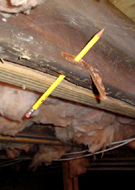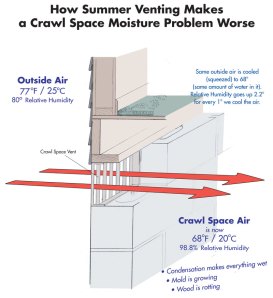Don’t Let your Baltimore Basement Get Caught in the Rain! 5 Steps to a Dry Basement.
When it rains it pours in Baltimore! Are you loosing sleep with the recent heavy rains, afraid you might wake up to a flooded or wet basement?
Here’s some handy tips from Mr. Basement, Baltimore’s authority on basement and crawl space environments for a dry, worry free basement!1- Correct drainageEnsure roof water disperses properly.Run discharge lines to storm sewer (code in many areas)No negative grades (aka the ground shouldn’t slope towards your home!)2 – Seal any openings that may allow water intrusionWindow wells should be sealed and free of debris like leaves, trash and sticksDoor ‘trench’ floor drains should flow freely3 – Mind the sump pumpYour sump pump should have the correct pumping capacity for your home.It should be checked by our service department once per year – we service all brands of waterproofing pumps.The sump pit should have a secure cover to keep out kids, their toys and pets4 – Install a dependable battery back-up for the sump pump.Keep in mind that ll brands are NOT equal.Our UltraSumps have a state of the art charging system + high pumping capacity5 – Don’t waste money on consumer grade dehumidifiersEnergy grade dehumidifiers are not the most cost-effectice choice for your basement.Their energy efficiency is sub-standard, and running one to dry a basement can become very expensive.Instead, consider the Basement Doctor’s SaniDry professional grade dehumidifier and air filtration miracle machine.It removes 4 times more water than consumer grade dehumidifiers for a fraction of the cost.It filters your home’s air and connects to your home’s HVAC system.It’s like a dehumidifier on steroids!
Monthly Archives: September 2010
Old Houses #1: New Waterproofing Technologies to Help Old House Basements – by CyFree | HomeRefurbers.com :: home improvement, remodeling and building community
There is something about old houses that fascinates people. They have an almost inexplicable charm of their own, that we can’t help but fall in love with.
Ask anyone who ever bought a distressed old house to restore and they will try to explain their investment by pointing to the richness of architectural details, the sturdiness of the construction, its historical value. Some will happily tell you about how they were on a budget, and what a great deal it was buying such a gem so cheap. They will happily tell you that when they put some work to it, the property value will soar.
But the truth is that buying an old house is, for the most part, an emotional choice and, restoring it is a labor of love.
One of the main problems homeowners face when restoring old houses, are the chronically wet basements.
Since basements are buried in wet ground, with materials that are porous (concrete, bricks, stone), the soil around the foundation walls needs to be kept as dry as possible, year round, to prevent basement leaks, basement floods and wet basement problems.
If you are restoring an old house, there are several steps you need to take to accomplish that, including:
– Keep gutters clean and in good working conditions. Install them if you don’t have any or upgrade old, rusty ones.
– Extend downspouts to discharge as far from the house as possible
– Grade the terrain as to slope away from the house
– Improve foundation drainage.Modern houses are built with french drains, which are perforated pipes buried by the footing, to provide adequate drainage. Old houses, on the other hand, may not have such systems in place. Because builders didn’t know back then what we know now, many of these houses have improper foundation drainage, and some have no drainage system in place at all.
In addition, because conventional french drains tend to fail overtime, some houses have them but they are now clogged or collapsed.
Installing or replacing a conventional french drain in an old house can be a hassle. You will need to dig out foundations, disturb the landscape and, if the house has a deck or a porch, it will need to be completely removed so that the french drain can be buried by the footing. In an old house, that can be specially challenging: the great wood used to build it as well as priceless antique embellishments can be damaged in the process.
There are, however, modern alternatives to conventional french drains that can be installed with much less disruption and for a fraction of the cost: internal perimeter drainage systems.
For the past 20 years, internal drainage systems have been using with success to stop basement leaks. They are installed by jack hammering a few inches of the basement floor, close to the wall and installing a drain tile that will intercept the ground water and divert it to a sump pump.
Besides the easier installation, these systems can be fitted with service ports and will remain serviceable for the life of the structure, unlike conventional french drains. That is why good basement waterproofing companies offer Transferable Lifetime Warranties on their internal perimeter drainage systems.
Working Sump Pump in a Leaky Basement: What is Wrong? : Basement Files
Working Sump Pump in a Leaky Basement: What is Wrong?
I am frequently approached by customers puzzled by the fact that their basements, despite having a good working sump pump and sometimes even a backup, still leaks.
Aren’t sump pumps supposed to prevent leaks?Yes they are, in part.The truth is that, the sump pump alone, in one corner of the basement will not keep it dry if there is nothing to divert the water to that sump pit.To keep your basement dry, all the water around the foundation needs to be intercepted and collected by a good, working drainage system. Water is pretty tricky, If you don’t intercept it and divert properly, it will follow the path of least resistance and find its way into the basement.If your house is not too old, chances are that you have a french drain or weeping tile buried by the foundation footing to collect the water. However, if the sump pump and backup system are working and you are still getting water in the basement, your french drain is clearly not working.It is clogged, improperly installed or simply collapsed.When that happens, a lot of homeowners are told by contractors to install additional pumps in the leaky corners of the basement. In our experience, only homes set in specially high water tables or built over underground springs really need more that one sump pit and sump pump system.The vast majority of basement leaks can be solved with a good drainage system and a powerfull sump pump system.In other words, until you get that drainage problem fixed, no amount of sump pumps will give you a guaranteed dry basement.The good news is that, thanks to new basement waterproofing technologies, a new drainage system can be installed without digging out the foundationsModern internal perimeter drainage systems can be installed inside the basement, along the internal perimeter of the basement walls, with much less disruption and for about half of the cost of conventional french drains.
Crawl Space Vents in TN: Common “Non-Sense”?
After many years in denial, trying to go on with your life without thinking too much about it, one day you decide to finally do something about that wet, moldy, scary crawlspace under your house.
Crawl spaces have a pretty steady temperature year round (around 68 degrees) and, during summer, they are naturally cooler than the outside: usually 10 to 20 degrees. So, let’s say we have a nice day outside, with 77 degrees and an average 80% relative humidity. Your crawl space temperature is 20 degrees cooler. When that air from outside comes in, it will cool down too.
Basement Redeemers moldy crawl space solutions in the greater Memphis area.
Don’t postpone it any longer, give them a call today!
Basement Systems Wins Innovation Awar…
Basement Systems Wins Innovation Award – SEYMOUR, CT – Basement Systems is proud to announce that it has been awarde… http://ping.fm/clclF
Kentucky Homeowners with Flooded Base…
Kentucky Homeowners with Flooded Basements Seek Help From Master Dry http://ping.fm/PquYz


